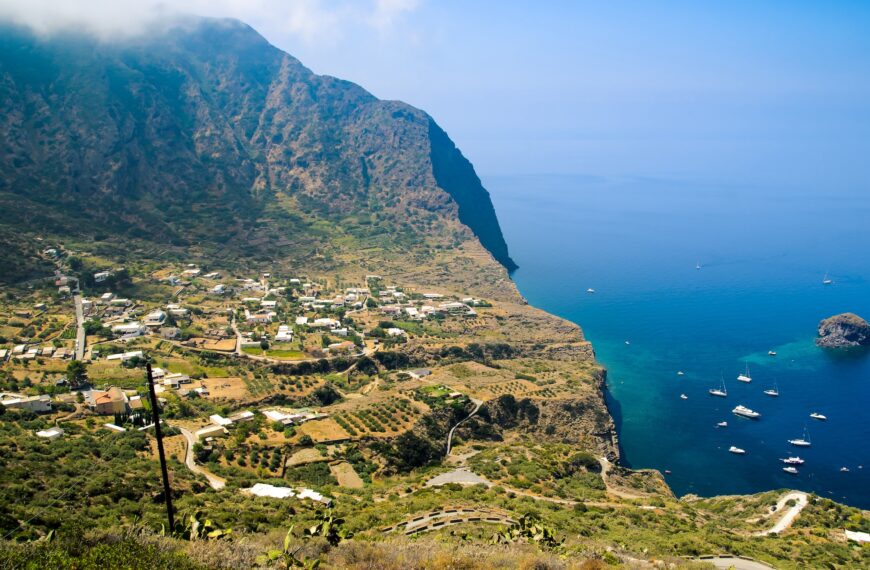The Amalfi Coast is an undeniable gem of beauty, but experiencing it by sea adds an extra touch of magic. Starting from Salerno, the first three stops we recommend include the unmissable jewels of Amalfi and Positano, alongside the hidden treasure of Cetara, a lesser-known but equally deserving destination.
Cetara
Famous for its beaches, Cetara is a fishing village that seems frozen in time. Starting from the coastline, the main beach is Marina, characterized by pastel-colored houses that make it a quintessential gathering spot for fishermen. While accessible by land, most other beaches here are reachable only by sea, enhancing the charm of a sailing holiday. On the western coast, for example, lies Collata Beach. Nestled in a cove and shielded from the wind, it features a pebble-strewn shoreline. Just beyond it is a tiny, romantic beach surrounded by cliffs, aptly named “Lovers’ Beach.”
To the east of the village, you’ll find treasures like Lannio Beach, whose name derives from the lament (lannio) of monks who, according to legend, were slain here by Saracens and whose cries are said to still echo. Lannio’s sandy shores are interspersed with smooth flat rocks. Nearby, just 50 meters away, is Tuoro Vecchio Beach, accessible by land only through a private hotel but easily reachable by boat. It is often praised as one of the most picturesque spots in the region. Lastly, a visit to Campana Beach is worthwhile for its view of small sea stacks, reachable solely by sea.
In town, surprises abound. One notable landmark is the Viceregal Tower, visible from the sea. Built during the Angevin era for surveillance and defense, it became part of a system of about 400 towers defending southern Italy’s coasts after the Turkish landing in 1534. Over the centuries, it was modified and expanded, with an additional two stories added during the late 19th century. Reopened in 2011, the tower now houses a Civic Museum. Other highlights include the churches of San Francesco d’Assisi, Santa Maria di Costantinopoli, and San Pietro Apostolo, ideal for a visit after a dip or a snack featuring local delicacies like the famous anchovy sauce.
Amalfi
A quintessential stop along the coast is Amalfi, the city that gave the coast its name. Once a powerful Maritime Republic and one of the Mediterranean’s most important trade hubs with the East, Amalfi’s pastel-colored houses cling to steep slopes, reflecting an urban design influenced by its Eastern connections. This influence is evident in the labyrinth of narrow alleys and stairways adorned with flowers and lemon plants.
The must-see landmark here is the Cathedral of St. Andrew. Built in an Arab-Norman style and later modified with Gothic and Baroque elements, the 9th-century complex includes the Basilica of the Crucifix, the Crypt of St. Andrew (housing the saint’s remains), and the famous Cloister of Paradise.
For beaches, the main one is Spiaggia Grande (or Marina), close to the town center. Its mix of sand and pebbles makes it a lively meeting point, with popular restaurants and nightlife nearby. For those seeking tranquility, quieter beaches can be reached only by sea or, in the case of Duoglio Beach, after descending 400 steps with panoramic views. Nearby, Santa Croce Beach offers crystal-clear waters and a more secluded vibe. Though small, it is well-equipped and boasts excellent restaurants.
Positano
The third essential destination on the Amalfi Coast is Positano. Built vertically along cliffs plunging into the sea, its layout dates back to the 13th century, with narrow streets, watchtowers, and fortifications. Exploring Positano means wandering through its 12 districts, each with a church, and discovering charming restaurants, artisan shops, and galleries.
Among the churches, Santa Maria Assunta stands out, with its iconic yellow-and-green majolica dome, a symbol of the town itself.
The main beach is Marina Grande, the heart of Positano’s vibrant social life and a tourist hotspot. Laurito Beach, though small and often crowded, gets its name from the laurel trees in the area. For those seeking a quieter escape, Fornillo Beach is a great choice, accessible via a pathway from the Marina Grande pier. Finally, there’s Arienzo Beach, reachable by land only after descending 300 steps, rewarding visitors with a peaceful and scenic retreat.





